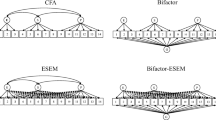Abstract
We examined the utility of the Psychosomatic Symptom Checklist in an inpatient medical setting with particular emphasis on the putative ability of the PSC to discriminate psychosomatic from nonpsychosomatic patients. First, 80 hospitalized psychosomatic patients were compared to 80 hospitalized medical patients on the PSC. Second, a sample of 187 psychosomatic patients was studied to examine the relationship among psychosomatic distress, depression, and functional impairment. The results indicate that while psychosomatic patients scored significantly higher than comparable medical patients on the PSC, discriminant analyses indicate that the PSC is not able to identify psychosomatic patients in an inpatient medical setting. Factor analyses and correlations show that the PSC is positively related to increased depression and decreased functional status. Results are interpreted in light of current psychosomatic theory.
Similar content being viewed by others
References
Andrasik, F., Blanchard, E., Arena, J., Teders, S., Teevan, R., and Rodichok, L. (1982). Psychological functioning in headache sufferers.Psychosom. Med. 44: 171–182.
Attanasio, V., Andrasik, F., Blanchard, E., and Arena, J. (1984). Psychosomatic properties of the SUNYA revision of the Psychosomatic Symptom Checklist.J. Behav. Med. 7: 247–258.
Blanchard, E., Andrasik, F., Appelbaum, K., Evans, D., Meyers, P., and Barron, K. (1986a). Three studies of the psychologic changes in chronic headache patients associated with biofeedback and relaxation therapies.Psychosom. Med. 48: 73–83.
Blanchard, E., Rodnitz, C., Evans, D., Schwarz, S., Neff, D., and Gerardi, M. (1986b). Psychological comparisons of irritable bowel syndrome to chronic tension and migraine headache and nonpatient controls.Biofeed. Self Reg. 11: 221–230.
Blanchard, E., Rodnitz, C., Schwarz, S., Neff, D., and Gerardi, M. (1987). Psychological changes associated with self-regulatory treatments in irritable bowel syndrome.Biofeed. Self Reg. 12: 31–37.
Bergner, M., Babbit, R., Carter, W., and Wilson, B. (1981). The Sickness Impact Profile: Development and final revision of a health status measure.Med. Care 19: 787–805.
Carroll, B., Feinberg, M., Smouse, P., Rawson, S., and Greden, J. (1981). The Carroll Rating Scale for Depression. I. Development reliability and validation.Br. J. Psychiat. 138: 194–200.
Chibnall, J., and Tait, R. (1989). The Psychosomatic Symptom Checklist revisited: Reliability and validity in a chronic pain population.J. Behav. Med. 12: 297–307.
Deyo, R., Inui, T., Lenninger, J., and Overman, S. (1982). Physical and psychosocial functioning in rheumatoid arthritis: Clinical use of a self-administered health status instrument.Arch. Intern. Med. 142: 879–882.
Follick, M., Smith, T., and Ahern, D. (1985). The Sickness Impact Profile: A global measure of disability in chronic low back pain.Pain 21: 67–76.
Holroyd, K., and Andrasik, F. (1978). Coping and self-control of chronic tension headache.J. Consult. Clin. Psychol. 46: 1036–1045.
Holroyd, K., Andrasik, F., and Nobel, J. (1980). A comparison of EMG biofeedback and a credible pseudotherapy in treating tension headache.J. Behav. Med. 3: 29–39.
Lipowski, Z. (1988). Somatization: The concept and its clinical application.Am. J. Psychiat. 145: 1358–1368.
McFarland, B., Freeborn, D., Mulloaly, J.,et al. (1985). Utilization patterns among long-term enrollees in a prepaid group practice health maintenance organization.Med. Care 23: 1221–1233.
Melzak, R. (1975). The McGill Pain Questionnaire: Major properties and scoring methods.Pain 1: 277–299.
Prestidge, B., and Lake, C. (1987). Prevalence and recognition of depression among primary care outpatients.J. Fam. Pract. 25: 67–72.
SAS (1985)SAS User's Guide: Statistics (Version 5 Edition), SAS Institute Inc., Cary NC.
Wallen, J., Pincus, H., Goldman, H.,et al. (1987). Psychiatric consultation in short-term general hospitals.Arch. Gen. Psychiat. 44: 163–168.
WHO (1985).International Classification of Health Problems in Primary Care, 3rd ed., Oxford University Press, New York.
Author information
Authors and Affiliations
Additional information
This research was supported in part by a grant from the Henry J. Kaiser Family Foundation.
Rights and permissions
About this article
Cite this article
Bombardier, C., Gorayeb, R., Jordan, J. et al. The utility of the Psychosomatic Symptom Checklist among hospitalized patients. J Behav Med 14, 369–382 (1991). https://doi.org/10.1007/BF00845113
Accepted:
Issue Date:
DOI: https://doi.org/10.1007/BF00845113



